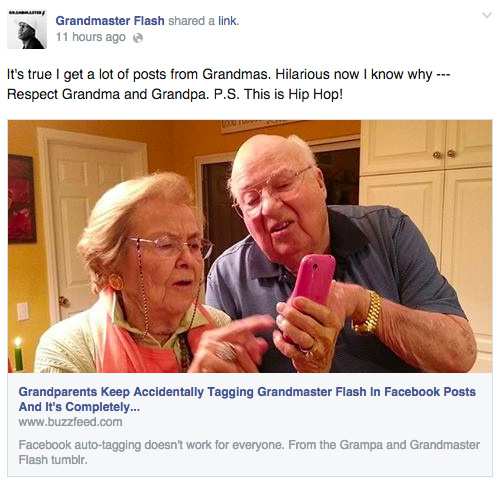Designing for Seniors, Respect Required

If you missed the phenomenon of the rather adorable grandmas tagging themselves as rapper Grandmaster Flash-yes it did happen albeit somewhat inadvertently-it brings up the important point that in designing for seniors we need to make additional affordances and recognize the difficulties they may face.

And why do grandma and grandpa matter to the tech industry? They're the most rapidly growing demographic on the Internet, now with over 60 percent of American seniors online and still growing, according to Pew Research. In the next decade as Baby Boomers continue to shift toward the senior spectrum, we will continue to see expanded growth in this demographic. Given the upcoming generation of seniors is expected to be the wealthiest yet, it would be imprudent not to cater to this demographic.
In designing for seniors it is important to recognize that they can face physical challenges in using technology and may have difficulties learning new technologies. Key areas where design considerations can be made are for vision and hearing, motor control, cognitive processing, and recognizing seniors may have a lack of experience with technology.
The good news is websites that are better designed to accommodate seniors are generally better for everyone. Let's take a look at a few sites that are getting it right.
-
AARP
With nearly 38 million members, the AARP's mission is to enhance the quality of life for all as they age. The AARP has made several key design decisions to help accommodate seniors on their website. The site uses a large text throughout and a san serif font which for people with low vision, is easier to process and recognize san serif characters. The site also makes use of warm colors, as vision declines so does the ability to discriminate certain hues. Seniors are more apt to confuse pale colors in the blue-green region of the spectrum with other pale colors. The red, yellow and orange colors AARP uses throughout its site are easier for seniors to differentiate, and the high-contrast AARP utilizes make it much easier for seniors as well.
Information overload is one of the most common problems identified for older users. Too much information on the page makes it hard to focus on relevant material. The AARP recognizes this and has a clean and uncluttered site making use of large headlines and concise descriptions to clearly separate and differentiate information
-
Social Security Administration
The Social Security Administration website has been quietly rolling out new features and updates and citizens are starting to take notice. In 2014, the SSA's achieved an excellent rating in the ForeSee 2014 E-Government Satisfaction Index, attributed to extra help with Medicare prescription drug plan costs with a score of 90 - they out performed several top private-sector brands including Amazon and Apple. In 2016, the SSA had the highest-scoring public sector sites dominating the federal website rankings and they also received ForeSee's Digital Excellence Award in part for having the greatest improvement in score since the start of measurement.
The Social Security Administration's website has great accessibility, in addition to supporting multiple languages and sign language, seniors who find it difficult to read online can use the BrowseAloud functionality to have the text spoken to them. The site also offers web accessibility help with information on increasing text size, magnifying the screen and changing background and text colors.
-
Road Scholar
Formerly Elderhostel, Road Scholar is the nation's first and world's largest educational and travel organization for adults 55 and over. Road Scholar has incorporated a generous text size in their website design and simplified the menu. Also, the elimination of fly-out menus with the replacement of menus that open with a single click or tap is a key design choice as some seniors struggle with precise motor movements and can become frustrated if they click in the wrong place. To accommodate a possible lack of precision with motor movement, larger button sizes have also been incorporated throughout the site.
Two other features which are great for all audiences appear as well. The phone number for help appears prominently on all pages and is easily visible, with further help just one click away and the site is responsive allowing for optimal viewing on any type of device.
As the senior demographic continues to grow and becomes increasingly tech savvy, we need to be more cognizant of the constraints seniors may face and make a greater effort to build sites that are inclusive for this demographic-especially if this is a demographic you're actively targeting. Key considerations designers should be aware of are for vision and hearing, motor control, and cognitive processing. If you're just getting started in designing senior friendly websites, here's a couple of great references to checkout:
- The National Institute on Aging has outlined a broad set of research-based guidelines that are an excellent resource and starting point.
- The Web Accessibility Initiative has a set of accessibility guidelines on developing websites for the elderly which can be found here: https://www.w3.org/WAI/older-users/developing/
Subscribe to Our Newsletter!
Latest in Web Design








